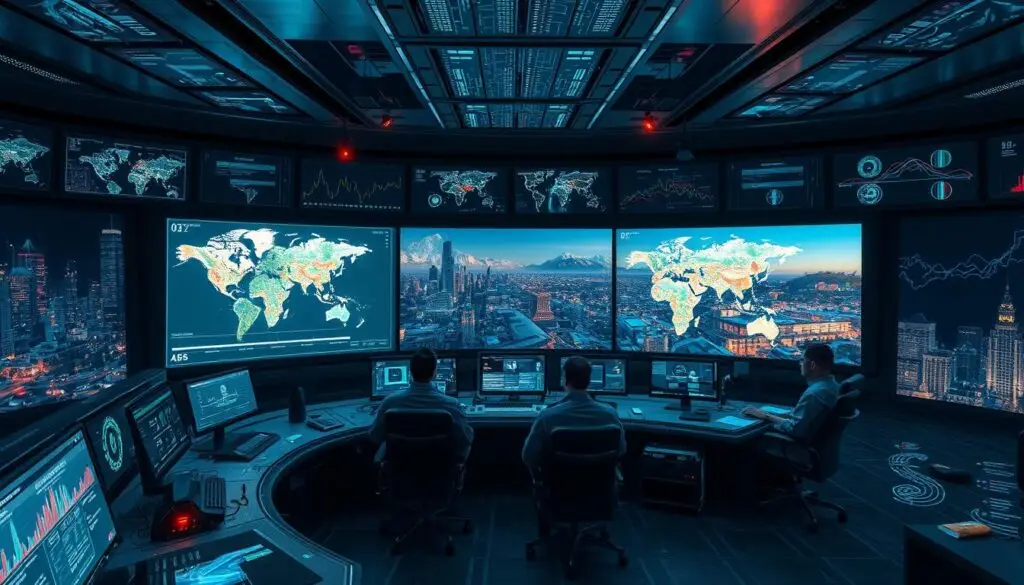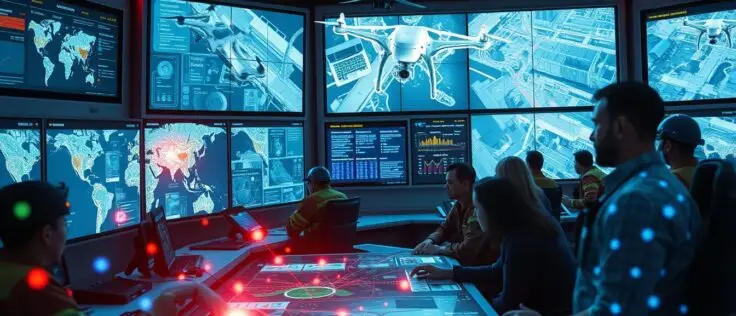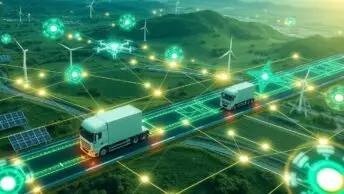AI is getting more essential in Disaster Management. It uses advanced analysis and predictions to change how countries manage Crisis Management and Emergency Response. Technologies like xView2 are making rescue efforts better, especially in places hit hard by disasters1.
xView2 was a big help after the 2023 Turkey earthquake. It helped teams on the ground to give focused and effective support12. This AI project helps quickly figure out and sort the damage, which helps in deciding where to send help first1. But, there’s a problem with needing clear daytime pictures, which means less help for places with little satellite service1.
With 23 big disasters in the US costing billions, and more extreme weather worldwide2, using AI in disaster plans is crucial for society. As we face more and worse disasters, AI could be our best bet not just to survive, but to adjust to these changes.
The Advent of AI in Disaster Management
AI has changed how we respond to disasters, making quick and accurate help possible. It has greatly improved the way emergencies are handled worldwide. Now, data analysis and forecasts are key in getting aid to affected places fast.
The Transformation of Response Strategies
Emergency strategies have changed thanks to AI. It helps us quickly understand lots of data for a faster, sharper response after disasters. AI can now predict events like hurricanes and earthquakes more accurately4.
In Nepal, AI is used to check earthquake risks and the safety of buildings. This means better preparation and stronger prevention methods are in place4.
xView2 and its Groundbreaking Contributions
xView2 is a big step forward in disaster management through AI. It analyses satellite images quickly to find damaged spots after a disaster. What used to take weeks is now done much faster, helping rescue and recovery efforts4. This shows AI’s role in making smart, timely decisions that can save lives.
From Predictive Analytics to Real-time Data Utilisation
AI’s use of live data has changed disaster response. For example, AI drones checked fire spread and damage during the 2019 Australian bushfires4. Google’s flood forecasting also shows AI’s power by sending flood warnings to many, helping prevent disasters5. These tools help us react and get ready for future threats.
Early Warning Systems Revolutionised by AI
Artificial Intelligence (AI) is changing the game in disaster management. It’s making Early Warning Systems much smarter. Now, with AI, we catch signs of floods faster through Machine Learning. This tech leap means we can spot earthquakes quicker, helping to save thousands of lives.
Accelerating Earthquake Detection with Machine Learning
Machine Learning now plays a big role in sniffing out earthquakes before they strike. At Oxford University, they use fancy AI to notice tiny shakes and movements underground. These early warnings6 help areas at risk get ready sooner, cutting down danger.
AI-Driven Flood Warnings Save Lives
In places where bad weather hits hard, AI-driven flood warnings are crucial. Google.org and the World Food Programme USA work together on these AI systems. They analyze weather patterns to foresee floods6. Quick alerts help evacuate people faster, saving lives as the climate changes.
AI isn’t just about floods and quakes. It’s also predicting hurricanes and wildfires with amazing accuracy7. This forward-thinking helps plan better and direct resources efficiently. It cuts down the bad effects disasters have on people and places.
The rise of AI has really changed the game for Early Warning Systems. We’re now much better at sending out early warnings. This keeps communities safer and makes managing disaster risks around the world much more effective.
Enhancements in Emergency Planning Through AI
AI is changing how we handle disasters, making plans more effective. Our world faces more natural disasters due to fast urban growth and climate change. AI helps us get ready for these disasters by giving us powerful tools to predict and manage them.
Companies like Maersk use AI to handle natural disasters better. They plan routes and manage stock with AI, reducing harm to the environment and dealing with problems better8. This shows how AI can help different areas work smarter.
In summary, AI is making a big difference in emergency planning. It allows us to understand and use our resources better, helping to lessen the damage from disasters. This is key for protecting people now and in the future.
Maximising Resource Allocation with AI Optimisation
In disaster management, AI Optimisation greatly helps by making sure Resource Allocation boosts Emergency Response. AI-driven tools let emergency teams assess damage accurately and quickly. This means they can get help to where it’s needed fast910. AI tech, like predictive models, helps us see how disasters could unfold. This improves how we use and share resources911.
AI also plays a big role in deciding where help goes first. It looks at lots of data to find the most critical spots. This makes sure emergency services are sent where they are most needed11. This method saves time and ensures no area is overlooked in disaster response1110. AI chatbots and communication tools are key for sending updates and organising help, making sure everyone knows what to do10.

AI doesn’t just help distribute goods better. It also helps manage people and support structures well. It predicts where disasters will happen, so we can prepare better. This saves lives and lessens harm911. As AI gets better, so does our ability to respond to emergencies quickly and with less damage10.
Crisis Management Supported by Predictive Analytics
Pattern Recognition in Humanitarian Crises
Advanced AI, like machine learning and natural language processing, spots hidden signs of future crises by analysing huge data sets. These insights help emergency teams prepare better, ensuring quick and accurate responses to humanitarian crises12. AI also helps create strategies to predict and lessen the impact of crises, making risk mitigation more effective12.
Forecasting for Proactive Disaster Response
AI is key in predicting natural events like floods or wildfires, offering advanced warnings to improve emergency responses13. Predictive models help assess risks, leading to better planning and faster reaction times. This approach quickens emergency aid and supports rebuilding efforts, helping communities recover and prevent future disasters13.
Tailoring Humanitarian Aid with AI Insights
Integrating AI into Humanitarian Aid significantly improves disaster relief. By using Predictive Analytics, it can pinpoint the urgent needs of populations. This ensures resources are used more efficiently. Studies show AI boosts outcomes in health and education, showing its wide potential in aid14.
Predictive Analytics also tackle logistical challenges in aid delivery. They are expected to raise efficiency and better manage resources and assessment tools. This fosters a strong, ethical framework for AI in humanitarian uses14.
Major global bodies and governments are increasingly focusing on anticipatory action. Germany, for instance, has dedicated a big part of its aid budget to such actions. Other G7 countries are also upping their support, marking a global move towards AI-based predictive strategies in disaster mitigation15.
AI is clearly reshaping Humanitarian Aid, making it more responsive to the changing needs of disaster areas. With ongoing innovation and dedication, AI promises to make Disaster Relief more proactive, personalised, and efficient. This will help communities around the world recover and become more resilient.
Real-Time Data: Leveraging AI for Immediate Action
After natural disasters strike, using real-time data via AI is key for quick action and better emergency responses. The big earthquake in Al Haouz, Morocco in 2023 showed us how fast we need to act. It left 2,946 people dead, 5,674 hurt, and over 50,000 homes in ruins16.
AI has improved how we foretell, warn early, and manage disasters. It’s a big step towards decreasing damage and smartly using resources. This tech supports major goals like SDG 11 (Sustainable Cities), SDG 13 (Climate Action), and SDG 15 (Life on Land). It shows how we can use technology for the good of society and our planet16.
These AI systems are really precise. They can predict earthquakes with up to 70% accuracy a week early. Deep learning models also predict rainfall accurately 24 hours before it happens. This helps us get ready faster for disasters that are coming our way16.
Research also points to big steps forward in flooding response. AI models that predict flooded roads are right 98% of the time17.
Furthermore, AI has changed how we send aid during emergencies. It uses maths to make smart choices, getting help to places fast and efficiently. This proves how AI can change the game in responding to emergencies16.
These technologies play a big part in bouncing back faster and saving more lives. Using real-time data, AI doesn’t just help now but promises to better future disaster responses. This makes it crucial in our world filled with tech.
Risk Reduction Strategies Enhanced by AI Solutions
AI solutions have greatly improved how we reduce risks, helping us find and lower the impact on areas at risk. AI algorithms look for patterns showing possible disasters. This allows us to take action early1819. This early action is crucial in reducing damage and keeping people safe in danger zones.
AI Algorithms for Identifying Vulnerable Zones
Minimising Impact Through Strategic Deployments
To learn more about how AI helps different industries work better, like making inventory management more efficient, check out this article.
Challenges and Opportunities in AI-Driven Disaster Responses
Using AI in disaster response in the UK shows both problems and benefits. Ethical use of AI is a big worry. Leaders face the task of keeping AI operations open and fair. They also deal with following the law and updating these systems to handle new tech and the unpredictable nature of disasters. Yet, bringing humans and AI together looks promising. It helps organisations create teams that connect AI tools to their main goals.
Google’s Flood Hub uses AI to give advanced 7-day forecasts in 80 countries, helping to protect 460 million people21. This means organisations can warn people and act fast. Also, using tech like ANNs and CNN helps in examining satellite photos for quick alerts and deep data study22. Using AI Challenges as a method for betterment, tools like LSTM and BiLSTM offer real-time monitoring, key for predicting changes in disasters21.
Building strong AI-driven efforts needs lots of resources and a good mix of readiness and precision. When AI systems, like IFAM, send warnings from different sources like satellites and water sensors, they boost efficiency in crises21. Moreover, companies like FlyPolar and Amazon show how AI can change customer experiences. This hints at how AI can similarly benefit disaster management, helping to protect communities, buildings, and lives21.
FAQ
How are AI solutions improving disaster management and emergency response?
AI helps manage disasters by giving us better predictive analytics. It quickly assesses damages and puts resources where needed fast. During emergencies, AI aids in making swift decisions, boosting the rescue mission’s success.
What are the key contributions of the xView2 project to disaster management?
The xView2 project uses AI to analyse satellite pictures, spotting and categorising damage quickly after a disaster. Its tech speeds up recovery, helping groups like the United Nations and the World Bank.
How has the AI revolutionised Early Warning Systems for natural disasters?
AI has changed Early Warning Systems using machine learning to quickly spot seismic activities. It’s also upgraded flood warnings, saving lives with early alerts and helping us get ready sooner.
In what ways does AI enhance emergency planning and crisis management?
AI boosts emergency planning by forecasting possible disasters and suggesting actions. In crisis management, it guides on the best ways to distribute resources and evacuate, ensuring fair help across affected areas.
What role does AI play in resource allocation during disaster management?
AI is key in resource allocation, using real-time data to sort out damage levels and send help efficiently. It makes the aid distribution orderly and effective.
How does AI-powered predictive analytics support crisis management?
AI’s predictive analytics foresee crises by spotting emerging patterns. It prepares for hurricanes and emergencies in advance, aiming to lessen harm.
Can AI insights aid in delivering more targeted humanitarian aid?
Yes, AI improves aid delivery by identifying the most at-risk communities and predicting their needs. Thus, help is given out more effectively and quickly reaches those who really need it.
How crucial is the role of real-time data provided by AI systems during disasters?
Real-time data from AI is crucial for fast action in disasters. It helps response teams on the ground do a better job, helping affected communities more effectively.
How do AI solutions contribute to risk reduction in disaster-prone areas?
AI reduces risks by identifying likely disaster zones. By strategically placing resources and people, it lessens the impact in these high-risk places through smart preparation.
What are the challenges and opportunities of employing AI in disaster responses?
AI brings many chances to enhance disaster response but faces issues with ethics, laws, and adapting to new tech. Overcoming these means blending AI with human skills and investing in reliable AI programs.
Source Links
- How AI can actually be helpful in disaster response – https://www.technologyreview.com/2023/02/20/1068824/ai-actually-helpful-disaster-response-turkey-syria-earthquake/
- Potential Use of Artificial Intelligence (AI) in Disaster Risk and Emergency Health Management: A Critical Appraisal on Environmental Health – https://www.ncbi.nlm.nih.gov/pmc/articles/PMC10712270/
- Leveraging AI for effective emergency management and crisis response – https://www2.deloitte.com/us/en/insights/industry/public-sector/automation-and-generative-ai-in-government/leveraging-ai-in-emergency-management-and-crisis-response.html
- Harnessing AI for Disaster Management: Revolutionizing Response and Recovery – https://medium.com/@jeyadev_needhi/harnessing-ai-for-disaster-management-revolutionizing-response-and-recovery-0048f679e954
- AI for Disasters: Predicting, Managing, and Saving Lives – https://www.linkedin.com/pulse/ai-disasters-predicting-managing-saving-lives-david-cain-2mikc
- AI-led science innovation protects communities hit by climate change – https://www.ox.ac.uk/news/2024-06-25-ai-led-science-innovation-protects-communities-hit-climate-change
- The Role of AI in Disaster Management: Early Warning Systems and Predictive Analytics – https://www.linkedin.com/pulse/role-ai-disaster-management-early-warning-systems-vikash-agrawala-mbgac
- AI in Disaster Management:Transforming crisis response – https://ecoskills.academy/ai-in-disaster-managementtransforming-resilience/
- The Role of AI in Disaster Management and Humanitarian Aid – https://skillfloor.com/blog/the-role-of-ai-in-disaster-management-and-humanitarian-aid
- The Role of AI in Disaster Response and Management – https://blog.emb.global/role-of-ai-in-disaster-response-and-management/
- How can AI be used for disaster management? [2024] – https://digitaldefynd.com/IQ/ai-in-disaster-management/
- Artificial Intelligence in crisis management – https://ojs.vvg.hr/index.php/DKU/article/view/471
- AI for Emergency Response: Faster, Smarter, Safer | Japeto – https://www.japeto.ai/ai-for-emergency-response/
- PDF – https://ecohumanism.co.uk/joe/ecohumanism/article/download/3856/3064/11814
- PDF – https://www.anticipation-hub.org/Documents/Dialogue_Platforms/Global_Dialogue_Platform_2023_FINAL.pdf
- Takeaways From The Moroccan Earthquake – https://arxiv.org/html/2311.08999v2
- Leveraging big data and AI for disaster resilience and recovery – https://www.preventionweb.net/news/leveraging-big-data-and-ai-disaster-resilience-and-recovery
- Unlocking Solutions: AI For Disaster Management and Psychosocial Well-being – https://cris.unu.edu/unlocking-solutions-ai-disaster-management-and-psychosocial-well-being
- Exploring the Power of AI in Disaster Risk Reduction: How UNDRR harnesses technology – 3 SIDED CUBE – https://3sidedcube.com/exploring-the-power-of-ai-in-disaster-risk-reduction-how-undrr-harnesses-technology/
- Cultivating trust in AI for disaster management – https://www.preventionweb.net/news/cultivating-trust-ai-disaster-management
- AI and Disaster Management: potential and applications – About Resilience – https://www.aboutresilience.com/ai-and-disaster-management-potential-and-applications/
- Artificial Intelligence in Disaster Management: Effectiveness and Challenges – https://repository.stcloudstate.edu/cgi/viewcontent.cgi?article=1032&context=cjs_etds






